Have you ever wondered why some people seem to experience greater benefits from CBD than others? It all comes down to bioavailability. CBD bioavailability refers to the amount of CBD that is actually absorbed and utilized by the body. But what factors affect the bioavailability of CBD, and how can you optimize it to maximize its benefits? In this article, we’ll explore the different factors that influence CBD bioavailability and provide practical tips on how to enhance CBD absorption.
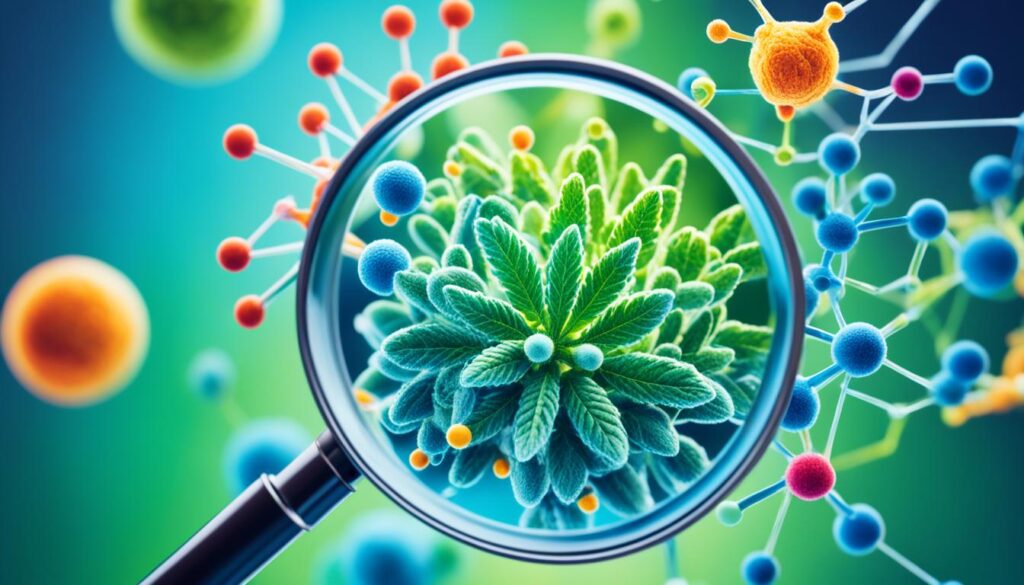
Key Takeaways:
- The method of consumption, such as sublingual administration and inhalation, can increase CBD bioavailability.
- The presence of fats, high-fat meals, and specific carrier oils can enhance CBD absorption.
- Certain substances or foods, like grapefruit juice, can impact CBD bioavailability.
- Choosing CBD products with advanced formulations can improve bioavailability.
- Individual factors, such as genetics and metabolism, can affect CBD bioavailability.
Factors Affecting CBD Bioavailability
Several factors can influence the bioavailability of CBD, affecting how effectively it is absorbed and utilized by the body. These factors include the method of consumption, the form of the product, the presence of certain substances or foods, and individual differences in metabolism.
When it comes to CBD consumption, the method plays a significant role. Oral consumption in the form of capsules or gummies, for example, has the lowest bioavailability. This is due to the digestive process and the first-pass metabolism that CBD goes through, reducing its absorption rate. On the other hand, sublingual administration, where CBD oil or tinctures are held under the tongue, and inhalation have higher bioavailability rates. In these methods, CBD bypasses the digestive system and enters the bloodstream more directly, allowing for better absorption and bioavailability.
In addition to the method of consumption, the form of the CBD product can also impact its bioavailability. Different formulations, such as oils, edibles, or topicals, may have varying absorption rates. For example, topicals like creams or lotions primarily target localized areas and have low systemic bioavailability, while oils or tinctures designed for sublingual use offer higher bioavailability.
Factors such as the presence of fats, high-fat meals, and specific carrier oils can also influence CBD absorption and bioavailability. Consuming CBD products with high-fat meals or with carrier oils like coconut oil or hemp seed oil can improve CBD absorption. This is because CBD is a lipophilic molecule, meaning it is soluble in fats and oils. When CBD is combined with fats or carried by oils, it enhances its bioavailability and allows for better absorption in the body.
It’s important to note that individual differences in metabolism can also impact CBD bioavailability. Factors such as genetics and overall health can affect the absorption and elimination of CBD, making bioavailability unique to each person. Additionally, certain substances or foods, like grapefruit juice, can inhibit the enzymes responsible for metabolizing CBD, increasing its bioavailability and prolonging its effects.
Understanding these factors that affect CBD bioavailability can help individuals make informed decisions when choosing CBD products and optimizing their absorption for maximum benefits.
Effective CBD Delivery Methods for Maximizing Bioavailability
When it comes to ensuring the optimal benefits of CBD, it’s crucial to choose effective delivery methods that enhance its bioavailability. By maximizing CBD’s bioavailability, you can improve its absorption and make the most out of its therapeutic potential. In this section, we’ll explore three effective CBD delivery methods that are known for their ability to enhance CBD absorption and maximize its benefits.
1. Sublingual Administration
Sublingual administration involves placing CBD oil or tinctures under the tongue, where it is held for a period of time before being swallowed. This method allows for direct absorption of CBD into the bloodstream via the capillaries under the tongue, bypassing the digestive system. Sublingual administration has gained popularity due to its ability to deliver CBD quickly and efficiently, resulting in higher bioavailability compared to oral consumption.
Through sublingual administration, CBD is absorbed into the bloodstream, allowing for faster onset and more immediate effects. This method is convenient and easy to use, making it a popular choice among CBD users seeking fast-acting relief. With sublingual administration, you can maximize the bioavailability of CBD and enjoy its benefits more effectively.
2. Inhalation
Inhalation of CBD involves vaping or smoking CBD products. This method offers high bioavailability as CBD is absorbed through the lungs and directly enters the bloodstream. The inhalation route allows for rapid absorption, with CBD reaching its peak concentration in the bloodstream within minutes. Inhalation is preferred by many users who prioritize immediate effects and convenient dosing.
Vaping or smoking CBD is a popular choice for individuals seeking quick relief or those who prefer the sensory experience associated with inhalation. By bypassing the digestive system and delivering CBD directly to the lungs, inhalation offers a highly effective method for maximizing the bioavailability of CBD and optimizing its benefits.
3. Rectal Administration
While less commonly used, rectal administration is another effective method for maximizing CBD bioavailability. By bypassing the first-pass metabolism in the liver, rectal administration allows for direct absorption of CBD into the bloodstream. CBD suppositories or rectal delivery systems are specifically designed for this method.
This delivery method is often chosen when other routes of administration are not feasible or when individuals seek enhanced bioavailability. Rectal administration of CBD can be particularly beneficial for individuals with gastrointestinal issues that may affect the absorption of CBD through oral consumption.
| Delivery Method | Bioavailability | Advantages |
|---|---|---|
| Sublingual Administration | High | – Direct absorption into the bloodstream – Quick onset of effects – Convenient and easy to use |
| Inhalation | High | – Rapid absorption through the lungs – Immediate effects – Convenient dosing |
| Rectal Administration | High | – Bypasses first-pass metabolism – Direct absorption into the bloodstream – Suitable for individuals with gastrointestinal issues |
By utilizing these effective CBD delivery methods, you can maximize the bioavailability of CBD and enhance its absorption for optimal therapeutic effects. Whether you prefer sublingual administration, inhalation, or rectal administration, each method offers unique advantages in terms of speed, convenience, and effectiveness. Experimenting with different delivery methods can help you find the best approach that aligns with your needs and preferences, ensuring you get the most out of your CBD experience.
The Role of Carrier Oils in CBD Bioavailability
When it comes to CBD bioavailability, the role of carrier oils cannot be overstated. CBD is a lipophilic molecule, meaning it readily dissolves in fats and oils. When CBD is combined with a carrier oil, such as coconut oil or hemp seed oil, it significantly improves its bioavailability.
The reason behind this is simple. The human body is more efficient at absorbing and utilizing CBD when it is carried by fats. The CBD molecules become more readily available for absorption, increasing their overall bioavailability.
Choosing CBD products that utilize high-quality carrier oils is essential for enhancing the bioavailability of CBD. By selecting products with these carrier oils, you are ensuring that your body can effectively absorb and utilize the CBD, maximizing its therapeutic benefits.
The Benefits of High-Quality Carrier Oils
High-quality carrier oils not only enhance the bioavailability of CBD but also offer additional benefits. Coconut oil, for example, is rich in medium-chain triglycerides (MCTs), which are easily metabolized by the body and can provide a quick source of energy. Hemp seed oil, on the other hand, is rich in omega-3 and omega-6 fatty acids, which have been shown to support overall health and well-being.
“Choosing CBD products that utilize high-quality carrier oils is essential for enhancing the bioavailability of CBD.”
Incorporating these carrier oils into CBD products creates a synergistic effect, combining the natural properties of the carrier oils with the therapeutic benefits of CBD. This results in a more effective and efficient CBD experience.
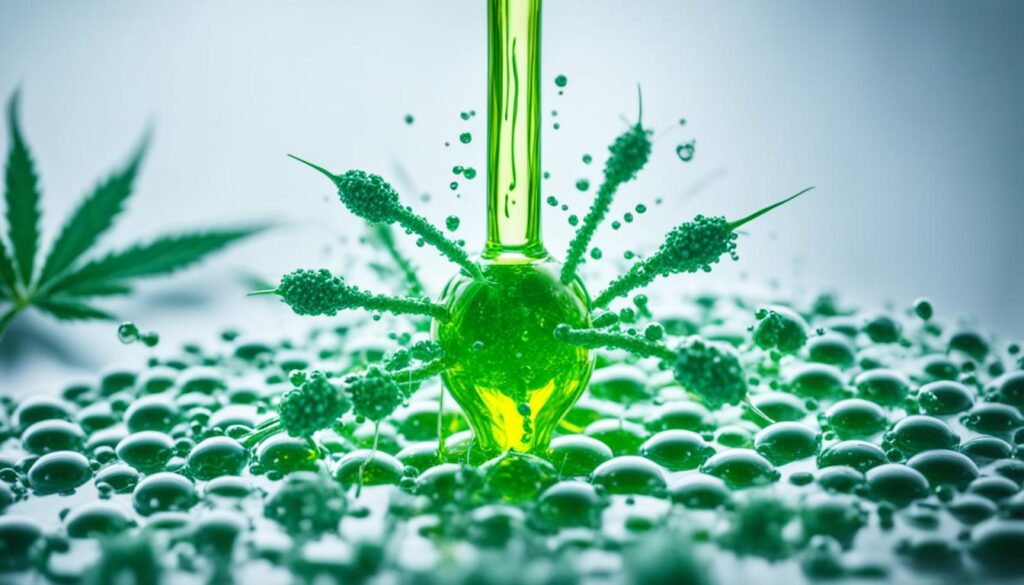
Choosing the Right CBD Products
When selecting CBD products, it’s crucial to consider the type of carrier oil used in the formulation. Look for products that explicitly state the carrier oil used and ensure that it is of high quality. Additionally, consider your own preferences and any dietary restrictions you may have. Some carrier oils, like coconut oil, may not be suitable for individuals with certain allergies or dietary restrictions.
By choosing CBD products with high-quality carrier oils, you are not only improving the bioavailability of CBD but also ensuring that you are using a product that aligns with your needs and preferences.
In Summary
The role of carrier oils in CBD bioavailability is significant. By combining CBD with carrier oils, the bioavailability and effectiveness of CBD products can be greatly enhanced. Choosing CBD products that utilize high-quality carrier oils, such as coconut oil or hemp seed oil, can help improve the absorption and utilization of CBD, maximizing its therapeutic benefits.
The Influence of Food on CBD Bioavailability
The presence of food can significantly affect the bioavailability of CBD. Studies have shown that consuming CBD with a high-fat meal can enhance its absorption rate and bioavailability. This is because cannabinoids, including CBD, are lipophilic and have a better solubility in fats than in water. By consuming CBD with fatty foods, its absorption can be improved by bypassing the first-pass metabolism and enhancing its bioavailability.
However, it’s worth noting that certain foods or substances, such as grapefruit juice, can inhibit the enzymes responsible for metabolizing CBD, thereby increasing its bioavailability and prolonging its effects.
The Impact of High-Fat Meals
Taking CBD with a meal high in fats can boost its absorption rate and bioavailability. The ingestion of CBD alongside fatty foods allows it to bind with the fats present, aiding in its efficient absorption. This process bypasses the first-pass metabolism in the liver, leading to higher CBD concentrations in the bloodstream. As a result, the user may experience increased therapeutic effects and a prolonged duration of action.
Research has suggested that the specific composition of the meal can play a role as well. A study published in the European Journal of Clinical Pharmacology found that CBD absorption was highest when taken with a meal containing 30% fat content.
“Consuming CBD with fatty foods can help improve its absorption by bypassing the first-pass metabolism and enhancing its bioavailability.”
It’s important to note that not all fats are created equal; healthy fats, such as those found in avocado, nuts, and olive oil, are preferable choices when considering CBD absorption. These fats provide additional nutritional benefits while aiding in the bioavailability of CBD.
The Role of Grapefruit Juice
Grapefruit juice is known to impact the metabolism of certain medications by inhibiting specific enzymes in the liver. Similarly, it can affect the metabolism of CBD, potentially increasing its bioavailability. The inhibition of these enzymes results in prolonged CBD effects and higher concentrations of the cannabinoid in the bloodstream.
However, individuals should exercise caution when consuming grapefruit juice alongside CBD, as it can also increase the risk of potential drug interactions. It’s always recommended to consult with a healthcare professional before combining CBD with grapefruit juice or any other substances.
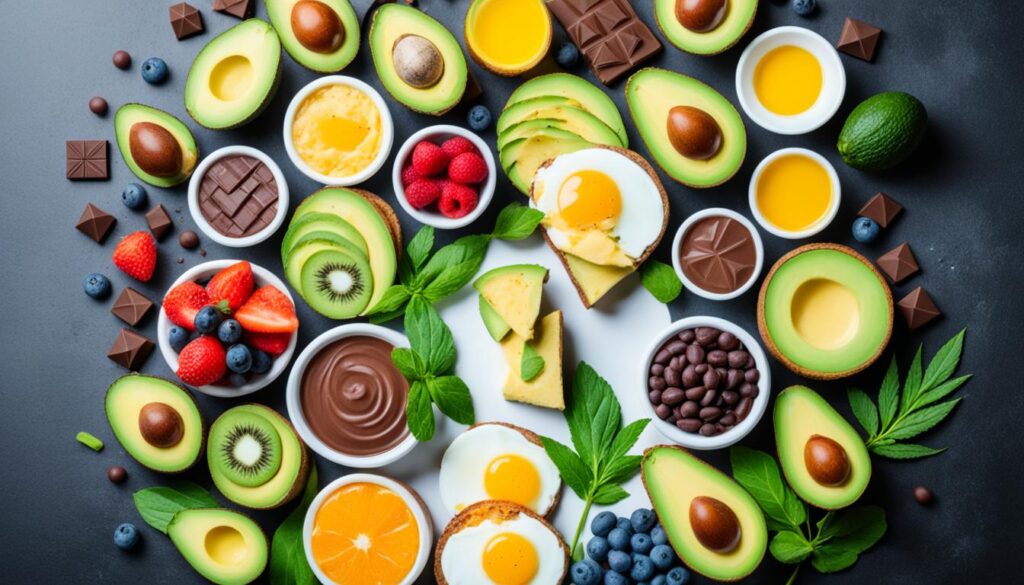
Foods That May Enhance or Inhibit CBD Bioavailability
| Foods or Substances | Effect on CBD Bioavailability |
|---|---|
| High-fat meals | Enhances bioavailability and absorption |
| Grapefruit juice | Potentially increases bioavailability and prolongs effects |
| Healthy fats (avocado, nuts, olive oil) | Aids in CBD absorption and provides additional nutritional benefits |
| Foods high in fiber | May delay CBD absorption but does not significantly impact bioavailability |
By understanding how different foods can influence CBD bioavailability, individuals can make informed decisions about their CBD consumption. However, it’s important to note that individual responses may vary, and it’s always advisable to consult with a healthcare professional for personalized advice.
The Importance of CBD Formulations for Bioavailability
The formulation of CBD products plays a crucial role in enhancing their bioavailability. Various formulations have been developed to improve the absorption and utilization of CBD, ultimately maximizing its effects on the body.
“Choosing CBD products that utilize advanced formulations can help optimize CBD bioavailability and ensure maximum absorption for enhanced effects.”
One such formulation is nanoemulsions. These are CBD products that have been broken down into tiny droplets, allowing for better solubility and absorption by the body. The smaller particle size of nanoemulsions increases the surface area of the CBD, making it easier for the body to absorb and utilize. As a result, the bioavailability of CBD is significantly enhanced.
Liposomal formulations are another innovative approach to improving CBD bioavailability. Liposomes are small vesicles that encapsulate CBD, protecting it from degradation in the digestive system and enabling efficient absorption into the bloodstream.
Self-nanoemulsifying drug delivery systems (SNEDDS) are also gaining popularity in the CBD industry. These systems use a combination of oil, surfactants, and co-solvents to create self-emulsifying formulations. SNEDDS enhance the solubility of CBD, making it easier for the body to absorb and utilize.
“Choosing CBD products that utilize advanced formulations can help optimize CBD bioavailability and ensure maximum absorption for enhanced effects.”
| Formulation | Description |
|---|---|
| Nanoemulsions | A CBD formulation broken down into tiny droplets, improving solubility and absorption. |
| Liposomal Formulations | Liposomes encapsulate CBD, protecting it from degradation and enhancing absorption. |
| Self-Nanoemulsifying Drug Delivery Systems (SNEDDS) | Oil-based formulations that enhance solubility and absorption of CBD. |
“Choosing CBD products that utilize advanced formulations can help optimize CBD bioavailability and ensure maximum absorption for enhanced effects.”
By selecting CBD products that incorporate these advanced formulations, individuals can enhance the bioavailability of CBD and improve the overall effectiveness of their CBD supplementation routine.

Considerations for CBD Bioavailability in Different Routes of Administration
Different routes of administration can greatly affect the bioavailability of CBD, determining how efficiently the cannabinoid is absorbed and utilized by the body. By understanding the factors that influence CBD bioavailability, you can make informed decisions about the most effective delivery methods for enhancing the effects of CBD. Here, we explore the various routes of administration and their considerations:
1. Oral Consumption:
Oral consumption of CBD in the form of capsules, edibles, or beverages is a popular method. However, it has lower bioavailability due to the digestive process and first-pass metabolism. CBD must pass through the digestive system, where it may undergo breakdown or loss before reaching the bloodstream. This can result in a reduced amount of CBD being absorbed and utilized by the body.
2. Sublingual Administration:
Sublingual administration involves placing CBD oil or tinctures under the tongue for a period of time, allowing it to be absorbed directly into the bloodstream through the sublingual glands. This method bypasses the digestive system and liver, leading to higher bioavailability rates compared to oral consumption. It offers a faster onset of effects and allows for the efficient absorption of CBD.
3. Inhalation:
Inhalation of CBD through vaping or smoking allows for rapid absorption of CBD into the bloodstream through the lungs. This method offers high bioavailability as CBD bypasses the digestive system entirely. Inhalation provides quick effects and is favored by individuals who prefer immediate relief or a faster onset of CBD’s therapeutic benefits.
4. Topical Application:
Topical application involves applying CBD-infused products directly onto the skin, such as creams or lotions. While this method offers localized relief, it has lower bioavailability compared to oral or inhalation methods. CBD’s absorption through the skin is limited, and it may not reach the bloodstream in significant amounts. However, topical CBD can still provide benefits for specific areas of the body.
5. Rectal Administration:
Rectal administration involves the insertion of CBD suppositories or enemas into the rectum. This method bypasses the digestive system and liver, allowing CBD to be absorbed directly into the bloodstream. Rectal administration has been shown to offer high bioavailability rates, making it an effective option for individuals seeking efficient CBD absorption.
It’s important to consider your goals, preferences, and individual needs when choosing a route of administration for CBD. Each method has its own advantages and considerations. For example, sublingual administration and inhalation offer higher bioavailability, making them ideal for individuals seeking fast-acting effects. On the other hand, oral consumption may be more convenient for those who prefer a discreet and easy-to-use option.
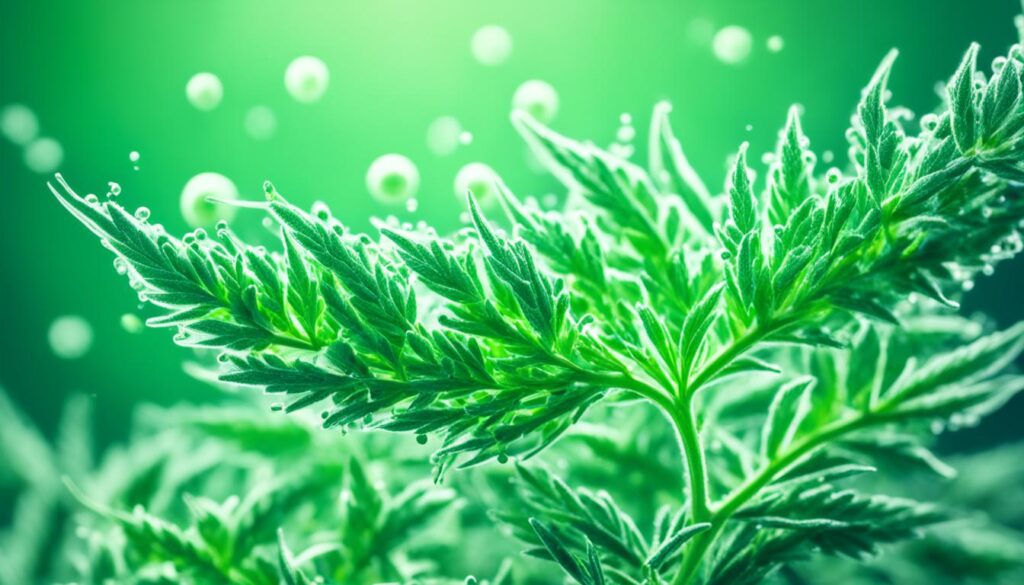
By understanding the various routes of administration and their impact on bioavailability, you can select the most suitable method to enhance the effects of CBD and optimize its bioavailability.
| Route of Administration | Bioavailability |
|---|---|
| Oral Consumption | Lower bioavailability due to digestive process and first-pass metabolism. |
| Sublingual Administration | Higher bioavailability as CBD absorbs directly into the bloodstream through sublingual glands. |
| Inhalation | High bioavailability as CBD bypasses the digestive system and quickly enters the bloodstream through the lungs. |
| Topical Application | Lower bioavailability as CBD absorption through the skin is limited. |
| Rectal Administration | High bioavailability as CBD directly enters the bloodstream, bypassing the digestive system. |
Choose the route of administration that best aligns with your needs and preferences to enhance the bioavailability of CBD and maximize its therapeutic effects.
CBD Bioavailability in Different Populations
CBD bioavailability can vary among different populations due to factors such as genetics, metabolism, and overall health. Individual differences in liver function and metabolism can affect the absorption and elimination of CBD, making bioavailability unique to each person. Additionally, certain medical conditions or medications may further impact CBD bioavailability.
It’s important for individuals to consult with a healthcare professional to determine the most effective CBD dosage and administration method based on their specific needs and circumstances. By understanding their personal bioavailability and considering any potential interactions with medications or health conditions, individuals can optimize the use of CBD products and enhance their therapeutic benefits.
Factors Influencing CBD Bioavailability among Different Populations
When it comes to CBD bioavailability, there are several factors that can influence how the body absorbs and utilizes the cannabinoid. These factors include:
- Genetics: Genetic variations can impact how the body metabolizes CBD, affecting its bioavailability and overall effectiveness.
- Metabolism: The rate at which the body metabolizes substances can influence CBD absorption. Individuals with a faster metabolism may experience higher bioavailability.
- Overall Health: The overall health of an individual, including liver and kidney function, can impact CBD bioavailability and the body’s ability to process and eliminate the cannabinoid.
Consulting with a Healthcare Professional
To navigate the complexities of CBD bioavailability in different populations, it’s crucial to seek guidance from a healthcare professional. They can provide personalized advice and recommendations based on factors such as medical history, current medications, and individual health needs.
Working with a healthcare professional can help ensure that individuals are using CBD products in a way that maximizes bioavailability and optimizes the potential benefits. By considering individual differences and taking into account any potential interactions or contraindications, healthcare professionals can help individuals make informed decisions about CBD dosage, administration method, and product selection.
The Future of CBD Bioavailability Research
The field of CBD bioavailability research is continuously evolving, with ongoing studies aiming to further understand the factors that affect CBD absorption and utilization. Researchers are exploring new delivery methods, formulations, and technologies to enhance the bioavailability of CBD and maximize its potential therapeutic benefits.
Advancements in CBD Delivery Systems
Advancements in CBD delivery systems are playing a key role in enhancing the bioavailability of CBD. Scientists are developing innovative methods to improve CBD absorption and ensure its efficient utilization by the body. This includes the exploration of nanotechnology, liposomal formulations, and self-nanoemulsifying drug delivery systems.
Through these advancements, CBD molecules can be formulated into smaller particles and encapsulated to increase their solubility and stability. This allows for better absorption and utilization by the body, leading to enhanced bioavailability and more consistent therapeutic effects.
Exploring Novel Formulations
In addition to delivery systems, researchers are also investigating novel formulations to optimize CBD bioavailability. These formulations aim to enhance the solubility and permeability of CBD, improving its absorption by the body.
Formulations such as nanoemulsions and liposomal encapsulations have shown promise in increasing CBD’s bioavailability. These formulations help to overcome the challenges of CBD’s poor water solubility and low permeability, allowing for better absorption and utilization.
Investigating Factors Affecting CBD Bioavailability
Understanding the factors that affect CBD bioavailability is crucial for optimizing its therapeutic effects. Researchers are conducting studies to investigate various factors, including metabolism, genetics, and specific food-drug interactions.
By gaining a deeper understanding of these factors, researchers can develop personalized approaches to CBD supplementation that consider individual differences in bioavailability. This will enable individuals to achieve the maximum benefits from CBD based on their unique physiological characteristics.
Collaborative Efforts and Clinical Trials
Collaborative efforts among researchers, regulatory bodies, and the CBD industry are vital for advancing CBD bioavailability research. By working together, researchers can access a larger pool of resources, expertise, and funding to conduct comprehensive clinical trials.
Clinical trials provide valuable insights into the bioavailability of CBD products and their effects on different populations. These trials help to validate the effectiveness of new delivery methods and formulations, ensuring that individuals have access to safe and reliable CBD products with enhanced bioavailability.
Practical Tips for Maximizing CBD Bioavailability
When it comes to reaping the full benefits of CBD, maximizing its bioavailability is key. By enhancing the bioavailability of CBD, you can ensure that your body absorbs and utilizes the cannabinoid to its fullest potential. Here are some practical tips to help you maximize CBD bioavailability:
- Consider using sublingual CBD products: Sublingual administration involves placing CBD oil or tinctures under your tongue. This method allows the CBD to bypass the digestive system and enter the bloodstream directly. By doing so, sublingual consumption maximizes CBD absorption and enhances its bioavailability.
- Take CBD with a high-fat meal: Consuming CBD with a high-fat meal can improve its absorption rate. CBD is a lipophilic molecule, meaning it dissolves in fats. By pairing CBD with a high-fat meal, you enhance its solubility and increase its bioavailability, allowing your body to better absorb and utilize the cannabinoid.
- Incorporate carrier oils: CBD products often come with carrier oils, such as coconut oil or hemp seed oil. These carrier oils enhance the bioavailability of CBD due to their ability to improve dissolution and absorption. When choosing CBD products, opt for those with high-quality carrier oils to maximize bioavailability and improve absorption.
- Experiment with different routes of administration: In addition to sublingual consumption, exploring alternative routes of administration can offer higher bioavailability. Inhalation and rectal administration are two methods known for their efficient CBD absorption. Inhalation allows CBD to be absorbed through the lungs, while rectal administration bypasses the first-pass metabolism, ensuring optimal absorption and bioavailability.
- Choose CBD products with advanced formulations: CBD formulations, such as nanoemulsions or liposomal formulations, have been developed to enhance CBD’s bioavailability. These advanced formulations improve the solubility and stability of CBD, enabling better absorption and utilization by the body. When selecting CBD products, prioritize those that utilize innovative formulations to optimize bioavailability.
By following these practical tips, you can enhance the bioavailability of CBD, improve its absorption, and maximize its benefits. Keep in mind that everyone’s body is unique, so it’s important to consult with a healthcare professional to determine the most appropriate methods and dosages for your specific needs. With the right approach, you can make the most of your CBD experience and enjoy the full potential of this incredible cannabinoid.
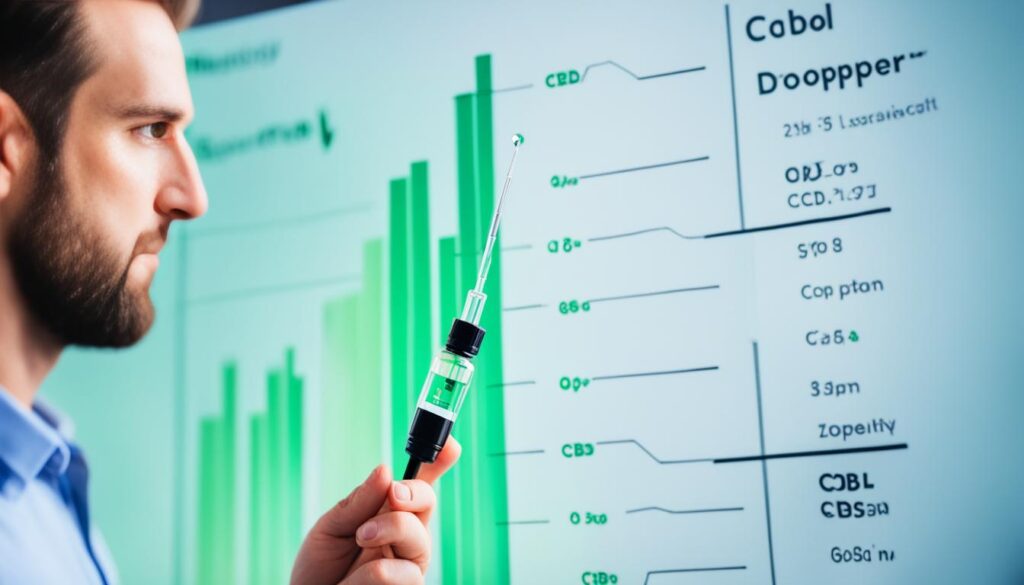
Conclusion
Maximizing CBD bioavailability is crucial for optimizing its therapeutic effects and maximizing its benefits. By understanding the factors that affect CBD absorption, such as the method of consumption, the presence of certain substances or foods, and individual differences in metabolism, individuals can make informed decisions when choosing CBD products.
One way to enhance CBD bioavailability is by selecting effective delivery methods, such as sublingual administration or inhalation, that bypass the digestive system and allow for direct absorption into the bloodstream. Utilizing CBD products with advanced formulations, like nanoemulsions or liposomal formulations, can also improve CBD absorption and utilization. Additionally, considering practical tips such as taking CBD with a high-fat meal or incorporating carrier oils can further enhance bioavailability.
To ensure the optimal absorption of CBD and maximize its benefits, it is important to consult with a healthcare professional for personalized advice and guidance. They can provide recommendations on the best approach to maximize CBD bioavailability based on individual needs and circumstances. By following these strategies and seeking professional guidance, individuals can optimize their CBD experience and benefit from its therapeutic properties.